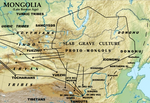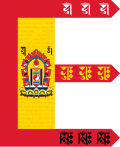The Ulaanzuukh culture, also Ulaanzuukh-Tevsh culture (Ch:乌兰朱和文化, c. 1450-1000 BCE), is an archaeological culture of the Late Bronze Age eastern Mongolia...
11 KB (1,186 words) - 02:35, 10 November 2024
least the Bronze Age. In particular, the people of the Ulaanzuukh culture and the Slab-grave culture are closely linked to the westward expansion of Neolithic...
32 KB (3,949 words) - 04:11, 18 November 2024
previously understood. The people of the Ulaanzuukh (1450–1150 BCE) and Slab Grave (1100–300 BCE) cultures were closely associated with the Ancient Northeast...
50 KB (5,847 words) - 11:20, 13 November 2024
culture, and continuing with the Okunev, Chemurchek, Munkhkhairkhan or Ulaanzuukh traditions. The deer stones themselves belong to one of the latest traditions...
81 KB (9,909 words) - 22:35, 8 November 2024
Afanasievo culture 3300–2500 BC Chemurchek culture 2750–1900 BC Munkhkhairkhan culture 1800–1600 BC Sagsai culture 1500–1000 BC Ulaanzuukh culture 1450–1150...
8 KB (643 words) - 07:17, 16 November 2024
Afanasievo culture 3300–2500 BC Chemurchek culture 2750–1900 BC Munkhkhairkhan culture 1800–1600 BC Sagsai culture 1500–1000 BC Ulaanzuukh culture 1450–1150...
26 KB (2,782 words) - 01:49, 8 November 2024
Mongolica, Mongol peace, enabled the spread of technologies, commodities, and culture between China and the West. Kublai expanded the Grand Canal from southern...
121 KB (13,876 words) - 06:19, 20 November 2024
future.[citation needed] Shamanic practices continue in present-day Mongol culture. According to Mongol legend, two warriors named Kiyan (Khiyad) and Negus...
14 KB (1,730 words) - 07:33, 8 November 2024
Afanasievo culture 3300–2500 BC Chemurchek culture 2750–1900 BC Munkhkhairkhan culture 1800–1600 BC Sagsai culture 1500–1000 BC Ulaanzuukh culture 1450–1150...
10 KB (1,075 words) - 12:58, 13 September 2024
Afanasievo culture 3300–2500 BC Chemurchek culture 2750–1900 BC Munkhkhairkhan culture 1800–1600 BC Sagsai culture 1500–1000 BC Ulaanzuukh culture 1450–1150...
6 KB (637 words) - 04:43, 16 November 2024
Afanasievo culture 3300–2500 BC Chemurchek culture 2750–1900 BC Munkhkhairkhan culture 1800–1600 BC Sagsai culture 1500–1000 BC Ulaanzuukh culture 1450–1150...
11 KB (1,423 words) - 23:25, 11 November 2024
east went to Yami Qaghan (603-09) as a sort of Sui vassal. He admired Han culture and had the Han people build him a civilized house in the Ordos country...
22 KB (2,421 words) - 19:57, 2 November 2024
Uyghur Khaganate (redirect from Culture of Uyghur Khanate)
1973), and an Iranian-related (BMAC-related) ancestry—together with Ulaanzuukh_SlabGrave (ANA-related) ancestry (Figure 3E). The admixture dates estimated...
48 KB (5,476 words) - 00:49, 31 October 2024
a higher degree of autonomy, and also retained their own language and culture during this period. The Khorchin Mongols allied with Nurhaci and the Jurchens...
48 KB (5,776 words) - 17:57, 21 July 2024
Chandman culture, and 7% consisted of newly introduced BMAC ancestry. The rest of the Xiongnu in the study generally had mainly Eastern Asian (Ulaanzuukh or...
12 KB (1,287 words) - 01:20, 21 April 2024
Afanasievo culture 3300–2500 BC Chemurchek culture 2750–1900 BC Munkhkhairkhan culture 1800–1600 BC Sagsai culture 1500–1000 BC Ulaanzuukh culture 1450–1150...
44 KB (5,310 words) - 01:54, 12 November 2024
Yenisei Kyrgyz correlated with the Čaatas culture [ru] and may perhaps be correlated to the Tashtyk culture. Their endonym was variously transcribed in...
27 KB (3,509 words) - 00:51, 31 October 2024
Afanasievo culture 3300–2500 BC Chemurchek culture 2750–1900 BC Munkhkhairkhan culture 1800–1600 BC Sagsai culture 1500–1000 BC Ulaanzuukh culture 1450–1150...
23 KB (2,408 words) - 14:03, 4 November 2024
Afanasievo culture 3300–2500 BC Chemurchek culture 2750–1900 BC Munkhkhairkhan culture 1800–1600 BC Sagsai culture 1500–1000 BC Ulaanzuukh culture 1450–1150...
50 KB (4,971 words) - 03:05, 27 September 2024
Afanasievo culture 3300–2500 BC Chemurchek culture 2750–1900 BC Munkhkhairkhan culture 1800–1600 BC Sagsai culture 1500–1000 BC Ulaanzuukh culture 1450–1150...
27 KB (2,749 words) - 10:43, 8 November 2024
Afanasievo culture 3300–2500 BC Chemurchek culture 2750–1900 BC Munkhkhairkhan culture 1800–1600 BC Sagsai culture 1500–1000 BC Ulaanzuukh culture 1450–1150...
13 KB (1,452 words) - 07:10, 20 November 2024
Afanasievo culture 3300–2500 BC Chemurchek culture 2750–1900 BC Munkhkhairkhan culture 1800–1600 BC Sagsai culture 1500–1000 BC Ulaanzuukh culture 1450–1150...
26 KB (3,352 words) - 13:35, 22 November 2024
Asian Masterpieces. Retrieved 16 June 2024. May, Timothy Michael (2008). Culture and customs of Mongolia. Greenwood Press. p. 22. "Namnansüren, Tögs-Ochiryn...
46 KB (5,252 words) - 23:06, 14 November 2024
Dzungar Khanate (section Culture)
consolidation of Turkic Muslim power in the region, since Turkic Muslim culture and identity was tolerated or even promoted by the Qing. In 1759, the Qing...
56 KB (6,167 words) - 22:29, 21 November 2024
Noble Latourette, Kenneth Scott (1964), The Chinese, their history and culture, Volumes 1-2, Macmillan Lorge, Peter A. (2008), The Asian Military Revolution:...
15 KB (1,613 words) - 03:08, 14 July 2024
Afanasievo culture 3300–2500 BC Chemurchek culture 2750–1900 BC Munkhkhairkhan culture 1800–1600 BC Sagsai culture 1500–1000 BC Ulaanzuukh culture 1450–1150...
23 KB (2,472 words) - 17:40, 9 November 2024
the region. It was followed by the Deer stones culture. At the same time the Ulaanzuukh-Tevsh culture was prospering in the steppes of southern and eastern...
4 KB (469 words) - 00:31, 24 June 2024
Afanasievo culture 3300–2500 BC Chemurchek culture 2750–1900 BC Munkhkhairkhan culture 1800–1600 BC Sagsai culture 1500–1000 BC Ulaanzuukh culture 1450–1150...
12 KB (1,208 words) - 16:53, 9 November 2024
Mongolia during the Copper and Bronze Age Afanasevo culture (3500–2500 BC). The Slab Grave culture of the late Bronze and early Iron Age, related to the...
126 KB (16,838 words) - 14:15, 7 September 2024



















